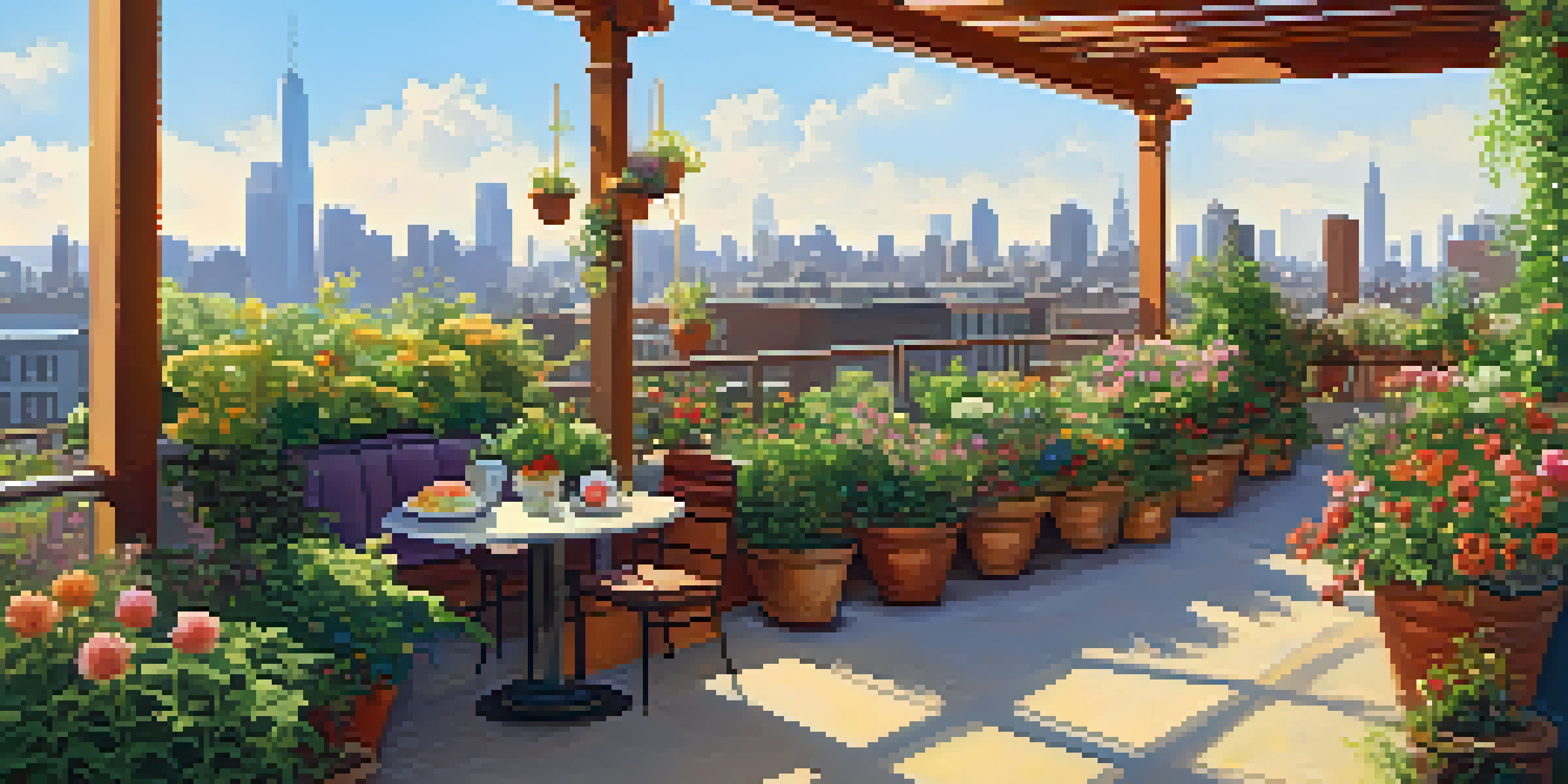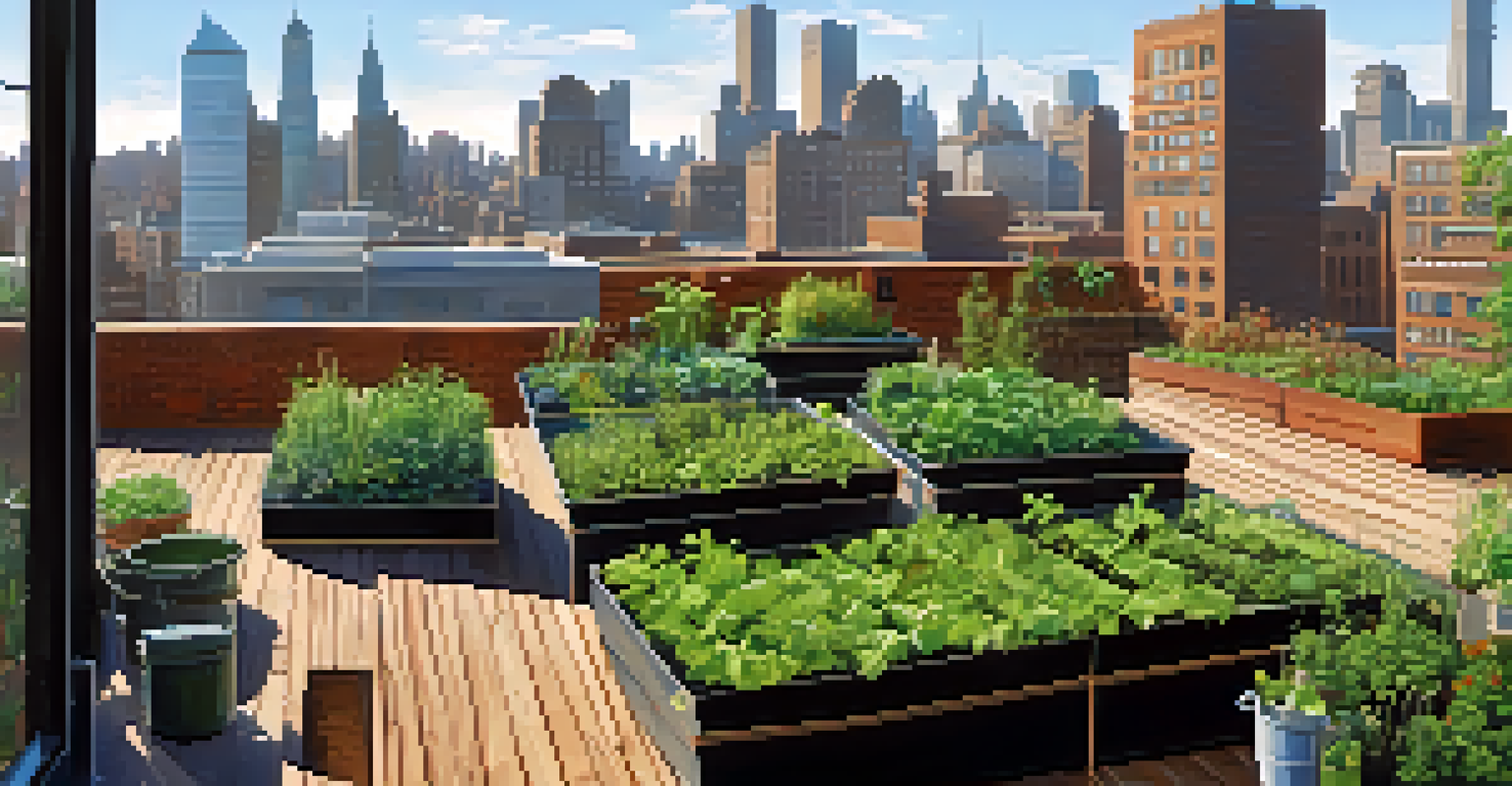Rooftop Gardens: Transforming Urban Rooftops into Green Oases

The Rise of Rooftop Gardens in Urban Areas
In recent years, rooftop gardens have become a popular trend in urban environments. As cities grow, the need for green spaces has never been more critical. Rooftop gardens offer a creative solution to this issue, allowing city dwellers to enjoy greenery right on top of their buildings.
In every walk with nature one receives far more than he seeks.
These gardens not only beautify the skyline but also contribute to environmental sustainability. By utilizing otherwise unused spaces, they help mitigate urban heat islands and improve air quality. For instance, a well-planned rooftop garden can reduce the temperature of a building by several degrees.
Moreover, the benefits of rooftop gardens extend beyond aesthetics and ecology. They provide opportunities for urban agriculture, enabling residents to grow their own vegetables and herbs, thereby fostering a sense of community and self-sufficiency.
Benefits of Rooftop Gardens for Urban Residents
Rooftop gardens offer numerous advantages for those living in bustling cityscapes. One of the most immediate benefits is the creation of personal green spaces that can serve as tranquil retreats from the urban hustle. Imagine sipping your morning coffee surrounded by blooming flowers and lush plants.

Additionally, these gardens can significantly improve mental health and well-being. Studies show that access to green spaces can reduce stress and promote relaxation. This is particularly valuable in cities where residents often feel disconnected from nature.
Rooftop Gardens Enhance Urban Living
Rooftop gardens provide essential green spaces, improving aesthetics and offering tranquil retreats for city residents.
Furthermore, rooftop gardens can enhance property value. Homeowners and renters alike are increasingly seeking properties that offer outdoor spaces, making these green oases not just a luxury but a smart investment.
Sustainability and Environmental Impact
Rooftop gardens play a pivotal role in promoting sustainability within urban settings. By reducing stormwater runoff, these green spaces help manage rainwater, which can alleviate pressure on city drainage systems. This is crucial in preventing flooding during heavy rains.
The best time to plant a tree was 20 years ago. The second best time is now.
They also contribute to reducing energy consumption in buildings. Plants provide insulation, which means less reliance on air conditioning during hot months. This not only lowers energy bills but also reduces the carbon footprint of the building.
In addition to these benefits, rooftop gardens support biodiversity by providing habitats for various species. Birds, butterflies, and beneficial insects can thrive in these urban oases, helping to restore ecological balance in densely populated areas.
Designing Your Rooftop Garden: Key Considerations
When planning a rooftop garden, several factors must be considered to ensure its success. First and foremost, structural integrity is vital. It's essential to assess whether the building can support the weight of soil, plants, and water.
Next, choosing the right plants is crucial for creating a thriving garden. Opt for native species that can withstand local climate conditions and require less maintenance. Incorporating a variety of plants not only enhances aesthetics but also promotes biodiversity.
Boosting Sustainability in Cities
These gardens help manage stormwater, reduce energy consumption, and support biodiversity, contributing to environmental sustainability.
Lastly, consider the garden's accessibility and usability. Creating comfortable seating areas and pathways can transform the rooftop into a true outdoor living space where residents can relax and enjoy the view.
Community Involvement and Urban Agriculture
Rooftop gardens can foster community involvement and strengthen social ties. Community gardens on rooftops encourage neighbors to work together, sharing not just gardening duties but also tips and harvests. This collaborative spirit can lead to lasting friendships and a sense of belonging.
Urban agriculture is another exciting aspect of rooftop gardening. Residents can grow their own food, reducing their reliance on store-bought produce. This not only promotes healthier eating but also lowers the carbon footprint associated with transporting food.
Engaging in rooftop gardening can also serve as an educational tool. Workshops and events can be organized to teach participants about sustainable gardening practices, making it a learning experience for all involved.
Challenges of Rooftop Gardening
While rooftop gardens offer many benefits, they also come with challenges. One of the primary concerns is water access, as rooftops may not have direct plumbing. Gardeners often need to find creative solutions for irrigation, such as rainwater harvesting systems.
Another challenge is the exposure to harsh weather conditions. Rooftop gardens can be subject to strong winds and intense sun, which may stress plants. Selecting resilient plants and providing adequate shade and windbreaks can help mitigate these effects.
Community and Urban Agriculture Benefits
Rooftop gardens encourage community involvement and promote urban agriculture, fostering healthier eating habits and social connections.
Lastly, maintenance can be a significant factor. While some plants are low-maintenance, others may require regular care to thrive. Planning for maintenance and possibly hiring professionals can ensure the garden remains a vibrant space.
The Future of Rooftop Gardens in Cities
As urbanization continues, the future of rooftop gardens looks promising. Cities around the world are recognizing the importance of green spaces and are implementing policies to encourage rooftop gardening. Some municipalities even offer incentives for building owners to create green roofs, reflecting a growing commitment to sustainability.
Technological advancements are also playing a role in the evolution of rooftop gardens. Innovations such as automated irrigation systems and modular gardening solutions make it easier for residents to maintain their green spaces, even in limited areas.

Ultimately, rooftop gardens can become integral parts of urban planning, contributing to healthier, more sustainable cities. As awareness grows, we can expect to see more green oases sprouting up across rooftops, enhancing our urban landscapes for generations to come.